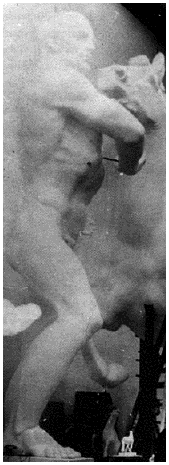A Jean-Louis St-Cyr
And Hermann Kohler
Investigation
J Robert Janes
(Soho)
 Let's be sure we get this one straight. It is 1942. The Nazis have taken over Paris. There is a Chief Inspector of the French police, St-Cyr, who works closely with a German Gestapo agent, Hermann Kohler. Their's is a tiring job --- they have to work around and at times against the various German and French bureaucracies. Kohler is not beloved of the German agencies like the Abwehr, and, of course, Sty-Cyr is seen as a collaborator.
Let's be sure we get this one straight. It is 1942. The Nazis have taken over Paris. There is a Chief Inspector of the French police, St-Cyr, who works closely with a German Gestapo agent, Hermann Kohler. Their's is a tiring job --- they have to work around and at times against the various German and French bureaucracies. Kohler is not beloved of the German agencies like the Abwehr, and, of course, Sty-Cyr is seen as a collaborator.
The strangeness is this: two should-be enemies are working together to solve your common-garden variety rape-
So despite the fantasy of it, we must wonder about this period as background --- a time when the state was enthusiastically pursuing a policy of destroying whole races and classes of people. Given that as a fact, should we be interested in following the fictional work of two fictional detectives working in fictional Paris in 1942?
Carousel may have its moments. Sometimes, the dialogue can be delicious. And whenever the details and names begin to overwhelm us, the author stops and runs through the lines again, to let us know exactly where we are. Most of the characters come to life --- especially a Dutch refugee by the name of Oona van der Lynn, a beautiful lady, who is so used to being forced into sex with various members of the Gestapo that when Kohler comes to question her, she automatically takes off her clothes until finally he forces her to stop. These are nice touches, but the overwhelming strangeness of it makes us wonder where Soho will be setting their next series of detective novels. The Donner pass at lunch-time? Christmastime the trenches of Flanders? Festivals in the Ukraine at the time of the collectivisation of the Kulaks?
Of course, the fault may be ours for bringing all our preknowledge of modern European history along with us. Perhaps there are some out there who haven't read much about Nazism, who might be able to take the irony of the times in stride. Perhaps some would see using this period where a democratic society was crushed by a brutal enemy as merry background for a merry detective novel --- and would thus not be put off by it.
This volume, by the way, is but one of nine in a series that stars the two detectives. Stonekiller, Salamander, Mannequin, and Mayhem are some of the others. They are said to be quite popular with people who have a weakness for this type of entertainment.